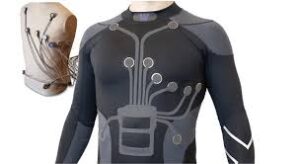“Quantum Sensors to Conductive Inks: Pioneering Smart Textiles and Decentralized Healthcare with IDTechEx”
Welcome, textile enthusiasts and tech-savvy readers! Today, we’re diving into the fascinating world of wearable technology with a special focus on smart textiles as explored by IDTechEx. They’ve been on a trailblazing journey through the latest in wearable tech, decentralized healthcare, conductive inks, quantum sensors, AR/VR headsets, and much more. As we navigate through these intricate developments, we’ll add some exciting insights into the key materials and processes driving these innovations. So, wrap yourself in this tapestry of technological textiles!
Decentralized Healthcare and Wearable Tech
One of the most revolutionary shifts in modern healthcare identified by IDTechEx is the decentralization facilitated by wearable technology. Imagine a future where VR goggles assist in interactive physio sessions, or you consult your doctor online without the hassle of traffic. Remote patient monitoring, a pivotal aspect of decentralized healthcare, allows healthcare providers to track vital signs in real time using smart textiles equipped with advanced sensors. This could lead to earlier diagnosis and intervention, improving patient outcomes
.
Smart Textiles: The Fabric of The Future
Smart textiles**, also known as electronic textiles or e-textiles, are fabrics integrated with electronic components such as sensors, actuators, and microcontrollers. One game-changing application within decentralized healthcare is the integration of **conductive fibers** that enable real-time health monitoring. For instance, fibers woven into your shirt could track heart rate, respiration, and even track muscle activity during workouts. This is achieved through conductive inks, a topic we’ll touch on later.
Conductive Inks: The Backbone of Printed Electronics
IDTechEx has shown that the conductive inks market is not only vast but also extremely segmented, with projections to exceed a value of US$6.5 billion by 2034. These inks are fundamental to the development of flexible, printable electronics, which are essential for creating advanced smart textiles.
What Are Conductive Inks?
Conductive inks** are a type of ink that conducts electricity – they consist of conductive materials, most commonly silver particles, dispersed in a liquid medium. While silver flake-based inks dominate the market due to their superior conductivity, emerging alternatives include copper and stretchable inks. These variants are critical for applications requiring greater flexibility and cost-effectiveness.
Silver Nano Inks** hold the promise of miniaturization, where minuscule circuits can be printed directly onto fabric. However, the challenge lies in balancing conductivity with stretchability, especially in textiles that need to endure significant flex and wear.
Quantum Sensors and Unjammable Sat-Navs
One breathtaking development is the role of quantum sensors in unjammable satellite navigation (Sat-Nav). In May 2024, a successful flight demonstration showcased the potential of quantum navigation technology. These sensors promise unprecedented accuracy and security, making them invaluable not just for military applications but also for smart textiles in aerospace and automotive industries.
Quantum Sensors Explained
Quantum sensors** utilize the principles of quantum mechanics to achieve sensitivity and precision unattainable by classical sensors. In the context of navigational systems, they can detect minute changes in gravitational fields, allowing for highly accurate positioning even when traditional GPS signals are unavailable. When integrated into smart textiles, these sensors could revolutionize how we navigate environments and track movements.
Wearables: From Anti-Aging Lights to Smart Mouthguards
IDTechEx also delves into a wide array of wearable technologies, including smart mouthguards that enhance safety in sports and red-light therapy wearables that promote anti-aging. These innovations exemplify the diverse capabilities of smart textiles.
Functional Fabrics
Red-light therapy wearables involve the use of
LED-embedded textiles** that emit specific wavelengths of light to promote cellular repair and rejuvenation, promising benefits for skin health. Smart mouthguards, on the other hand, feature embedded sensors that can provide real-time feedback on impacts and help prevent concussions, marking a significant advancement in sports safety.
Augmented and Virtual Reality Headsets
Augmented Reality (AR) and Virtual Reality (VR) are becoming more prominent with streamlined glasses and headsets enhancing both leisure and professional sectors. IDTechEx discusses how these technologies are transitioning from bulky, initial models to sleek, user-friendly devices suitable for various applications.
The Role of Optics in AR/VR
One crucial component in AR/VR devices is the integration of
high-definition optics**. These optics ensure a seamless, immersive experience by providing clear, realistic visuals. Advances in optics, such as waveguides and diffractive optics, are crucial for developing thinner, more sophisticated headsets.
Printed Sensors and Mass-Digitization
The role of printed sensors in digitizing everyday interactions cannot be overstated. They are integral to developing responsive and interactive smart textiles. IDTechEx’s forecasts highlight that the market for printed and flexible sensors will reach US$960 million by 2034.
Printed Sensors’ Mechanisms
Printed sensors** are produced by depositing conductive inks onto flexible substrates. This cost-effective approach allows for large-area sensor integration, making them ideal for smart clothing that must cover significant body areas to monitor diverse metrics. This flexibility aligns printed sensors with the fashion industry’s need for durability and comfort.
Quantum Random Number Generators (QRNGs)
Finally, let’s delve into another fascinating development: Quantum Random Number Generators (QRNGs). These devices leverage the inherent unpredictability of quantum mechanics to generate random numbers, which are crucial for secure data encryption. This non-deterministic nature makes QRNGs far superior to classical random number generators for safeguarding sensitive information.
QRNGs in Wearables
Imagine a smart textile that protects your personal data using quantum encryption – such textiles could be particularly valuable in military or corporate settings where security is paramount.
Conclusion
From decentralized healthcare to quantum sensors, conductive inks to AR/VR innovations, IDTechEx’s exploration of wearable technology highlights the tremendous potential of smart textiles. These advancements are stitching together a future where our clothes do more than just cover us—they interact with us, protect us, and even enhance our abilities. Whether it’s through health monitoring, immersive virtual experiences, or secure quantum communications, smart textiles are indeed the fabric of the future.
So, dear readers, as you don your favorite garment next time, ponder the potential it holds. Perhaps one day, it could be a piece of cutting-edge tech, seamlessly interwoven with the fabric of your life! Keep reading Textile Topher to stay ahead of the curve in the ever-evolving interface of textiles and technology.
Keywords: Smart Textiles, Conductive Inks, Decentralized Healthcare, (Post number: 70), AR/VR Headsets, Quantum Sensors





